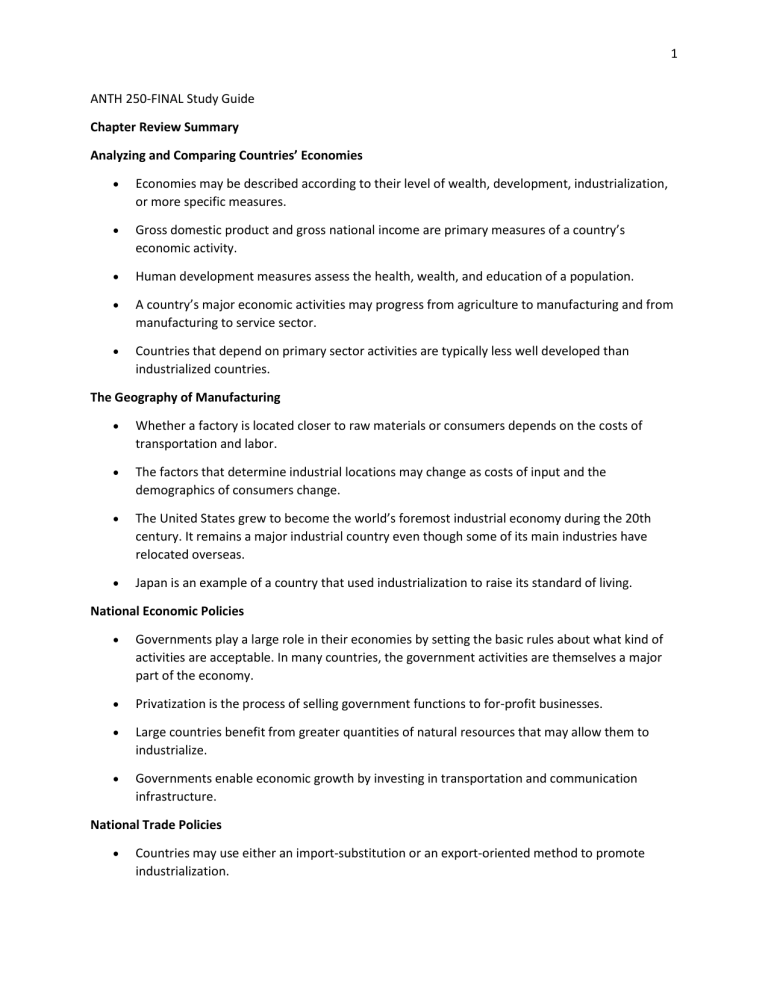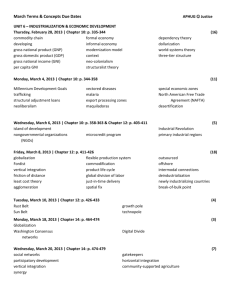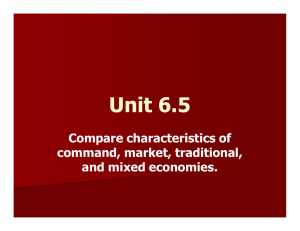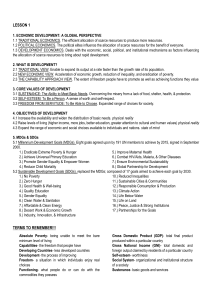
1 ANTH 250-FINAL Study Guide Chapter Review Summary Analyzing and Comparing Countries’ Economies Economies may be described according to their level of wealth, development, industrialization, or more specific measures. Gross domestic product and gross national income are primary measures of a country’s economic activity. Human development measures assess the health, wealth, and education of a population. A country’s major economic activities may progress from agriculture to manufacturing and from manufacturing to service sector. Countries that depend on primary sector activities are typically less well developed than industrialized countries. The Geography of Manufacturing Whether a factory is located closer to raw materials or consumers depends on the costs of transportation and labor. The factors that determine industrial locations may change as costs of input and the demographics of consumers change. The United States grew to become the world’s foremost industrial economy during the 20th century. It remains a major industrial country even though some of its main industries have relocated overseas. Japan is an example of a country that used industrialization to raise its standard of living. National Economic Policies Governments play a large role in their economies by setting the basic rules about what kind of activities are acceptable. In many countries, the government activities are themselves a major part of the economy. Privatization is the process of selling government functions to for-profit businesses. Large countries benefit from greater quantities of natural resources that may allow them to industrialize. Governments enable economic growth by investing in transportation and communication infrastructure. National Trade Policies Countries may use either an import-substitution or an export-oriented method to promote industrialization. 2 Most countries have adopted export-oriented policies that depend on increasing world trade. Industrial countries benefit more from this policy than do agricultural exporters. China has benefited greatly from adopting an export-orientated policy after 1979 and is today one of the leading manufacturing countries in the world. The Formation of the Global Economy Multinational corporations organize economic activities in several countries at once. International flows of investment capital has increased in recent decades. In most cases, these investments are between industrialized countries but flows to developing countries are increasing. Service sector activities, such as customer service, accounting, and design, are a growing part of global trade. The recession that began in 2008 highlights the risks of increasing economic interdependence. There are few regulatory bodies that can control some of the destructive effects of global economic crisis. Review and Discussion Questions 1. Define and explain the three sectors of an economy. What is sectoral evolution? extraction of raw materials (primary), manufacturing (secondary), and services (tertiary). ... In highly developed countries with a high income, the tertiary sector dominates the total output of the economy. 2. What locational determinants for manufacturing did Alfred Weber identify? What new determinants are important today? Alfred Weber stated that the determinants for manufacturing products are to be near the source of raw materials, to be close to a market, and have availability of a labor force. Now days transportation costs have fallen and the value of labor input has decreased 3. Differentiate laissez-faire capitalism from state-directed capitalism. "Laissez Faire" is French for "leave alone" which means that the government leaves the people alone regarding all economic activities. It is the separation of economy and state. State capitalism is an economic system in which the state undertakes commercial (i.e., forprofit) economic activity, and where the means of production are organized and managed as state-owned business enterprises (including the processes of capital accumulation, wage labor, and centralized management). 4. Why is transportation important to economic development? At the aggregate level, efficient transportation reduces costs in many economic sectors, while inefficient transportation increases these costs. 5. What are the three basic aspects of life measured by the human development index? A long and healthy life, being knowledgeable and have a decent standard of living. 3 6. Why might GNI differ from GDP for the same country? GNI measures all income of a country's residents and businesses, regardless of where it's produced. Gross domestic product, on the other hand, measures the income of anyone within a country's boundaries, regardless of who produces it. It includes anything earned by foreigners, including foreign businesses, while they are in the country. GDP measures production while GNI measures income.






